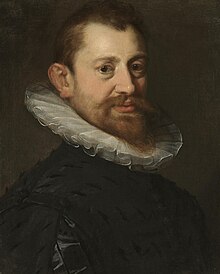Adrien de Vries
| Adriaen de Vries | |
|---|---|

Portrait by Hans von Aachen
|
|
| Born | Circa 1556 The Hague, Habsburg Netherlands |
| Died | 1626 Prague, Kingdom of Bohemia |
| Known for | Sculpting |
| Style | Northern Mannerism |
Adriaen de Vries (c.1556–1626) was a Northern Mannerist sculptor born in the Netherlands, whose international style crossed the threshold to the Baroque; he excelled in refined modelling and bronze casting and in the manipulation of patina and became the most famous European sculptor of his generation. He also excelled in draughtsmanship.
Born in The Hague to a patrician family, his early training is obscure; a recent suggestion suggests an apprenticeship with Willem Danielsz. van Tetrode, known in Italy as Guglielmo Fiammingo, a pupil of Benvenuto Cellini who had returned to the Netherlands. Another possibility is that he was apprenticed to a goldsmith, his brother-in-law Simon Adriaensz Rottermont. Both possibilities are suggestive in view of de Vries' virtuoso casting technique and refined finish.
He travelled to Florence, where, as early as 1581, he is documented working in the studio of the master Mannerist sculptor Giambologna, a Northerner like himself, and the greatest influence on his mature work. Three of the Virtues and some of the putti for Giambologna's Grimaldi Chapel, in San Francesco di Castelletto, Genoa (1579), have been attributed to Adriaen de Vries. In 1586 he was called to Milan to assist Pompeo, the son of the ailing Leone Leoni, whom he succeeded as master of one of Italy's largest bronze-casting studios; for Leoni de Vries provided three heroically-scaled saints for Leoni's high altar at the basilica of San Lorenzo at the Escorial.
This led to his brief appointment as court sculptor to Philip II's son-in-law Charles Emmanuel I, Duke of Savoy in Turin. In 1589-94 he worked for the first time in Prague, making busts and reliefs for Emperor Rudolf II. These sculptures are now housed in Vienna and at the Victoria and Albert Museum, which possesses a bust of Rudolf in bas-relief. He left Prague in 1594 for a visit to study in Rome. On his return through Germany he executed two fountains in 1596 for the city of Augsburg, the Mercury and Hercules and the Hydra fountains, which may still be seen in Maximilianstraße.
...
Wikipedia
